Serviços Personalizados
Journal
Artigo
Indicadores
-
 Citado por SciELO
Citado por SciELO -
 Acessos
Acessos
Links relacionados
-
 Similares em
SciELO
Similares em
SciELO
Compartilhar
GE-Portuguese Journal of Gastroenterology
versão impressa ISSN 2341-4545
GE Port J Gastroenterol vol.26 no.1 Lisboa fev. 2019
https://doi.org/10.1159/000487150
ORIGINAL ARTICLE
ERCP in Portugal: A Wide Survey on the Prevention of Post-ERCP Pancreatitis and Papillary Cannulation Techniques
CPRE em Portugal: Inquérito sobre a profilaxia de pancreatite e estratégias de canulação
Luís Lopesa–c, Jorge Canenad–g
aDepartment of Gastroenterology, Hospital de Santa Luzia, ULS Alto Minho, Viana do Castelo, Portugal; bLife and Health Sciences Research Institute (ICVS), School of Medicine, University of Minho, Braga, Portugal; cICVS/3B’s – PT Government Associate Laboratory, Braga/Guimarães, Portugal; dGastroenterology Center, Hospital Cuf Infante Santo – Nova Medical School/Faculdade de Ciências Médicas da UNL, Lisbon, Portugal; eDepartment of Gastroenterology, Hospital Amadora-Sintra, Amadora, Portugal; fDepartment of Gastroenterology, Hospital de Santo António dos Capuchos – CHLC, Lisbon, Portugal; gCintesis – Center for Health Technology and Services Research, Porto, Portugal
* Corresponding author.
ABSTRACT
Background/Aims: Recently the European Society of Gastrointestinal Endoscopy delivered guidelines on the prevention of post-endoscopic retrograde cholangiopancreatography pancreatitis (PEP) and on the papillary cannulation and sphincterotomy techniques at endoscopic retrograde cholangiopancreatography (ERCP). There are no data concerning current practices in Portugal. The aim of this study was to capture practice patterns of Portuguese pancreaticobiliary endoscopists with special interest in the prevention of PEP and cannulation techniques. Methods: A written survey was distributed to all pancreaticobiliary endoscopists attending the first Portuguese meeting dedicated to ERCP in November 2016. The main outcome measures were: technique used for standard biliary cannulation, use of nonsteroidal anti-inflammatory drugs (NSAIDs) in PEP, attempting prophylactic pancreatic stenting after using pancreatic guidewire (PGW)-assisted biliary cannulation in patients where biliary cannulation was difficult, and use of precut as the first rescue technique when biliary cannulation was difficult. Results: Completed surveys were collected from 28 of the 32 pancreatobiliary endoscopists attending the meeting (answer rate 87.5%). Biliary cannulation was performed using a guidewire access technique by the majority (77%), usually with a sphincterotome. When cannulation was unsuccessful, precut was the first choice for 70%. NSAIDs were administered routinely for PEP by only 54%; PGW-assisted biliary cannulation was the first choice after failed standard cannulation for a minority of them, and only 27% reported to routinely attempt insertion of a pancreatic stent. Highvolume endoscopists (> 150/year) tended to use NSAIDs and to insert a stent in PGW-assisted cannulation less often than low-volume-endoscopists (50 vs. 83.3%, p < 0.01, and 40 vs. 100%, p < 0.01, respectively). Precut was started without prior formal training by more than half of the endoscopists. Conclusions: There is a pronounced discrepancy between evidence-based guidelines and current clinical practice. This discrepancy is more pronounced in PEP prophylaxis, especially among high-volume endoscopists. Some advanced techniques in ERCP are initiated unsupervised, without any previous formal training. Key Message: There is a significant gap between guidelines and routine clinical practice.
Keywords: ERCP, Portugal, Post-ERCP pancreatitis, Papillary cannulation, Precut, Fistulotomy, Quality indicators,·Survey
RESUMO
Introdução/objetivos: Recentemente a Sociedade Europeia de Endoscopia Digestiva (SEED) publicou recomendações sobre a prevenção de pancreatite pós-CPRE (PPC) e canulação biliar e técnicas de esfincterotomia na CPRE. Não existe informação acerca da prática corrente da CPRE em Portugal, em especial na prevenção da PEP e das técnicas de canulação usadas. Métodos: Questionário escrito distribuído a todos os executantes de CPRE presentes numa reunião nacional. As análises principais pretendidas foram: técnicas usadas para a canulação biliar inicial; uso de AINEs na PPC, tentativa de colocação de próteses pancreáticas após recurso a canulação biliar difícil assistida por fio-guia pancreático; recurso ao précorte e infundibulotomia como técnica de recurso em canulações biliares difíceis. Resultados: Foram recolhidos 28 questionários, num total de 32 especialistas em CPRE autónomos e em actividade presentes na reunião (87.5% de taxa de resposta). A canulação biliar inicial é obtida com recurso a canulação assistida por fio-guia em 77% dos inquiridos, habitualmente usando um esfincterótomo. A técnica de recurso mais utilizada (70%) é o précorte, maioritariamente na forma de infundibulotomia. A utilização rotineira de AINEs é feita apenas por 27% dos inquiridos. A canulação biliar assistida por fio-guia pancreática (FGP) é a primeira opção numa minoria e apenas 27% tentam, rotineiramente, colocar prótese pancreática (PP) após esta manobra. Os endoscopistas com maior volume (> 150/ano) tendem a usar menos frequentemente os AINEs e a inserir uma PP na canulação assistida por FGP (50 vs. 83,3%, p < 0.01 respetivamente). O pré-corte é iniciado sem supervisão e sem treino especial por mais de metade dos endoscopistas. Conclusões: Existe clara discrepância entre as recomendações da SEED e a prática corrente em Portugal. Esta discrepância é mais pronunciada na profilaxia da PPC, especialmente em endoscopistas de maior volume. Algumas técnicas avançadas (précorte) são iniciadas sem supervisão e sem treino prévio. Mensagem chave: Existe clara discrepância entre as recomendações internacionais e a prática clínica diária.
Palavras-Chave: CPRE, Portugal, Pancreatite pós-CPRE, Canulação biliar,·Pre-corte, Fistulotomia, Indicadores de qualidade, Inquérito
Introduction
During the last decades, endoscopic retrograde cholangiopancreatography (ERCP) has become the standard of care for the treatment of many pancreaticobiliary diseases [1–3]. However, ERCP is a challenging technique with a slow learning curve and is associated with complications, some of them life-threatening [4–6]. Post- ERCP pancreatitis (PEP) is the most common and serious complication after ERCP [7]. A systematic survey of prospective studies including 16,885 unselected patients reported an incidence of PEP of approximately 3.5%. Severe pancreatitis was found in 11% of the cases, and death occurred in 3% of PEP cases [8]. Therefore, many attempts to reduce the rate of this complication have been pursued. Prophylactic pancreatic stenting and pharmacologic intervention, namely the use of rectal administration of 100 mg of diclofenac or indomethacin immediately before or after ERCP, have been successfully used in reducing the incidence of PEP, particularly in high-risk patients [9–12]. Furthermore, the success of biliary cannulation is influenced by patient factors (anatomy) and experience of the endoscopist [7, 13–15]. A harder challenge to access the desired duct often creates the need for more papillary cannulation attempts or rescue strategies. In the last years, papillary cannulation attempts have been shown to be an independent predictor of PEP [7, 13–15]. Therefore, the type and number of attempts, the strategy of cannulation (contrast- or guidewire-assisted), and the type of rescue technique (precut) used are all associated with PEP. Recently the European Society of Gastrointestinal Endoscopy (ESGE) delivered guidelines on the prevention of PEP and on the papillary cannulation and sphincterotomy techniques at ERCP [7, 13].
Previous surveys conducted elsewhere [16, 17] have shown that despite robust clinical evidence and published guidelines, most ERCP practitioners do not follow the proposed guidelines. Little is known about the situation in Portugal. Therefore, and in order to assess the current practices in Portugal, we performed a survey in a large audience of Portuguese pancreaticobiliary endoscopists. The aim of this study was to evaluate the preferences and practice patterns of our endoscopists in the prevention of PEP as well as the preferred strategies in standard and difficult biliary cannulation. Furthermore, we aimed to characterize Portuguese pancreaticobiliary endoscopists and their current practices.
Methods
This was a cross-sectional study using a written survey.
Study Population and Setting
All of the Portuguese pancreaticobiliary endoscopists attending the first Portuguese meeting dedicated to ERCP were invited to participate in a written survey. This 2-day course was held at the School of Medicine of the University of Minho, Braga during the last weekend of November 2016. There were 150 participants in the course, including 32 (80%) of the 40 Portuguese credentialed biliary endoscopists who perform ERCP in an autonomous environment. More than 90% of the chiefs of the national ERCP units were at the course. The survey was launched on the morning of the first day and was collected by the end of the day.
Study Design and Contents of the Questionnaire
The survey included 34 questions and was developed based on a previous questionnaire [18] as well as on the current ESGE guidelines concerning papillary cannulation and sphincterotomy techniques at ERCP [7] and prophylaxis of PEP [13]. The questionnaire (online supplementary appendix; for online suppl. material, see http://www.karger.com/doi/10.1159/000487150) was divided into four sections: (1) general data concerning age, years of practice, annual and overall volume of the endoscopist, as well as characteristics of the center, including main practice setting, (2) techniques of biliary cannulation used and rescue strategies in difficult cases, (3) strategies of PEP prophylaxis, and (4) using conventional precut and fistulotomy and type of training. All surveys were anonymous and no financial or other incentives were offered for completion of the questionnaires.
Data Collection and Analysis
The data obtained from the questionnaires were extracted and summarized on an electronic dedicated database. All answers were included for analysis when possible and blank answers (missing values) to individual questions were excluded from the analysis of that question.
Endpoints
The primary endpoints were assessment of (1) the standard biliary cannulation technique performed, (2) the use of precut after a difficult biliary cannulation, (3) the use of nonsteroidal anti-inflammatory drugs (NSAIDs) in PEP, and (4) the use of prophylactic pancreatic stenting in pancreatic guidewire (PGW)-assisted biliary cannulation. The secondary endpoints included the characterization of Portuguese biliary endoscopists, the overall biliary cannulation strategy, the type of training for precut, and the factors influencing the primary endpoints.
Predictors of Primary Endpoints
Five factors were evaluated as potential predictors: (1) annual ERCP load (categorized into two groups using 150 ERCPs/year as cutoff), (2) lifetime ERCPs performed (categorized into two groups using 2,000 ERCPs as cutoff), (3) number of years performing ERCP independently (categorized into two groups using 14 years as cutoff), (4) hospital setting (categorized into two groups: public hospital versus other settings), and (5) age of the endoscopist (categorized into two groups using 50 years as cutoff).
Statistical Analysis
Categorical data are shown as percentages and quantitative data as means and standard deviations. The potential factors associated with primary endpoints were assessed using univariate analysis. The univariate analysis was conducted using the χ2 test for categorical variables and the Student t test for continuous variables. All reported p values were for a two-tailed test, and p < 0.05 was considered to be statistically significant. All statistical analyses were performed using the Stata software package version 14 (Stata-Corp, College Station, TX, USA).
Results
Study Participants
The surveys were distributed to all individuals attending the meeting on the first day. The meeting’s audience included not only pancreaticobiliary endoscopists, but also gastroenterologists not performing ERCP, pancreaticobiliary endoscopists performing ERCP in other countries, residents of gastroenterology, and nurses. Only pancreaticobiliary endoscopists performing ERCP in Portugal without supervision were eligible for inclusion in the study. Thirty-two of the 40 (80%) endoscopists performing ERCP without supervision in Portugal were registered at the meeting. Completed surveys were collected from 28 of them (response rate 87.5%). These 28 endoscopists had performed at least 4,520 ERCPs in 2016, and on the whole had carried out more than 95,700 ERCPs during their career. The mean age was 50.4 years (standard deviation 9.59), and 89% were males (Table 1). The main practice setting was most often a public hospital (69%); 57.1% of the endoscopists had performed > 150 ERCPs per year in the last 2 years, and 64.3% of the endoscopists had performed > 2,000 ERCPs throughout their career.
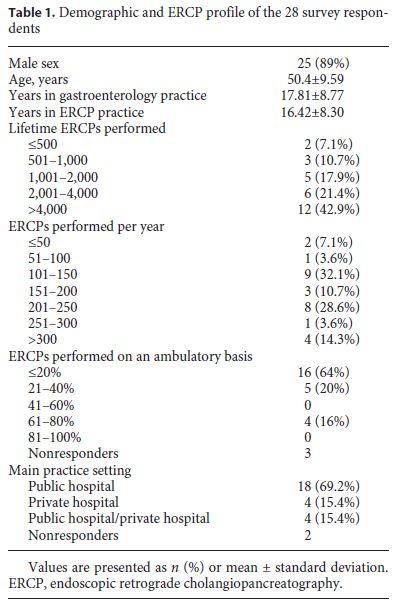
Biliary Cannulation Strategy
In patients with normal anatomy, biliary cannulation was performed using a guidewire access technique by 20 endoscopists (76.9%), most often with a sphincterotome (n = 18, 69.2%) (Table 2). In patients with a periampullary diverticulum (justadiverticular and/or intradiverticular) this was also the preferred approach, used by 21 (80.7%) and 23 (82.1%), respectively. A cannula, as the initial accessory elected, was used by a small minority of the surveyed endoscopists.
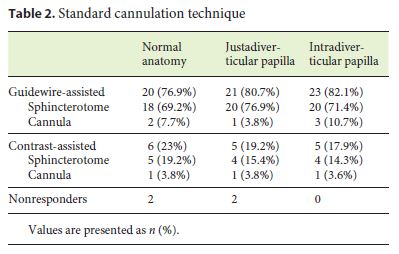
When the biliary cannulation was unsuccessful, precut was used by 19 endoscopists (73.1%) to achieve biliary access as long as the patients had a normal anatomy (Table 3). The next most common rescue technique among patients with normal anatomy was PGW-assisted biliary cannulation for 6 endoscopists (23.1%). When a patient had an intradiverticular papilla, the proportion of endoscopists using precut decreased to 37.5% (n = 9). Only 8.3% of the endoscopists claimed to suspend ERCP after an initial failed biliary cannulation, and only in the subgroup of patients with an intradiverticular papilla.
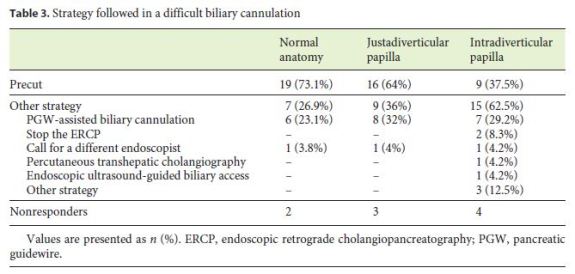
Practice of PEP Prophylaxis
Although 15 endoscopists (53.6%) used NSAIDs in all ERCPs (Table 4), there were 8 endoscopists (17.8%) who used NSAIDs in < 25% of the ERCPs performed. Among the 13 endoscopists who did not use NSAIDs in every ERCP, the following reasons were given: 6 (50%) used NSAIDs but only for PEP in high-risk patients, 2 (16.7%) were not convinced about its protective role against PEP, and 2 (16.7%) attempted a pancreatic stent insertion when NSAIDs was not used. When a PGW-assisted biliary cannulation was performed, only 7 endoscopists (26.9%) reported to always attempt pancreatic stenting; 46.2% of the endoscopists reported attempting prophylactic pancreatic stenting in < 50% of the ERCPs using a PGW-assisted biliary technique. When precut was used, pancreatic stents for PEP were inserted in < 25% of the procedures by 11 endoscopists (40.7%). There were 7 endoscopists (25.9%) who used pancreatic stents in > 75% of the occasions.
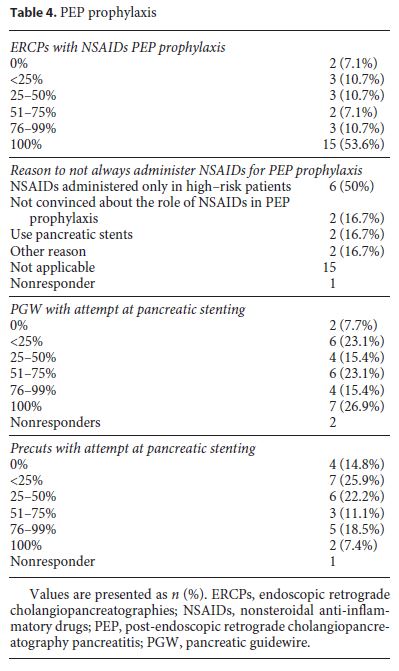
Precut and Training
The rate of precut use after an initial failure to cannulate ranges from none to up to 20% of all cannulations. Two endoscopists (7.7%) reported to never have used precut in the previous 2 years, whereas 6 (23.1%) reported a precut rate between 16 and 20% over all ERCPs performed in naïve papilla (Table 5). The needle knife was the most common accessory used, reported by 89.3% of the endoscopists (n = 25), followed by a traction papillotome (7.1%). Regarding the type of precut performed, conventional precut and fistulotomy were the most common, used by 13 endoscopists each (46.4%). Precut had been learned during a formal training period by 9 endoscopists (40.9%). Thirteen endoscopists (60.1%) had begun performing precut by themselves, unsupervised, without any previous formal hands-on training.
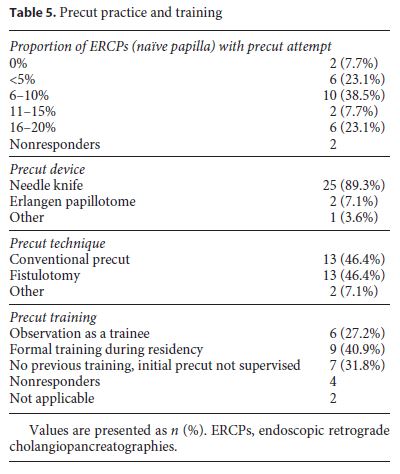
NSAIDs for PEP
We performed a univariate analysis to assess factors associated with the use of NSAIDs for PEP (Table 6). The proportion of ERCPs in which NSAIDs were used for PEP was categorized into two groups: use of NSAIDs in ≥75% of the ERCPs versus use of NSAIDs in < 75% of the procedures. There was an association between the annual load of ERCPs performed and the use of NSAIDs. Highvolume endoscopists used NSAIDs less often (50% of the ERCPs) than low-volume endoscopists (83.3% of the ERCPs) (p = 0.049). There were no significant differences with the other factors evaluated.
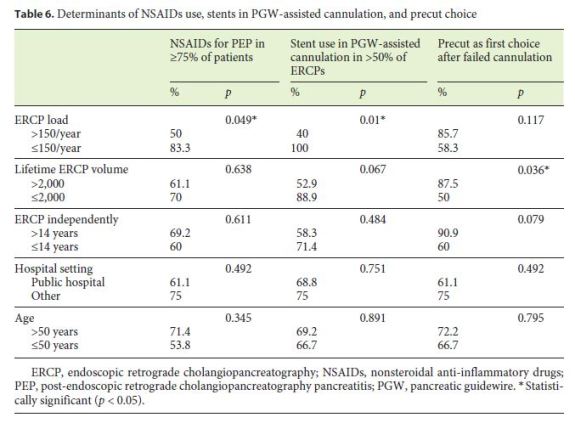
Stents and PGW-Assisted Biliary Cannulation
The proportion of PGW-assisted biliary cannulations in which pancreatic stenting was attempted was divided in two groups: use of pancreatic stents in ≥50% of the ERCPs versus use of pancreatic stents in < 50% of the procedures. Low-volume endoscopists insert a pancreatic stent after PGW-assisted biliary cannulation more often (100%) compared with high-volume endoscopists, who only used pancreatic stents in 40% of the ERCPs (p = 0.01) (Table 6). There were no significant differences with the other factors evaluated.
Precut after Failed Biliary Cannulation
We performed univariate analysis to assess factors associated with the use of precut as the first choice after failed biliary cannulation in patients with normal anatomy (Table 6). Endoscopists who had performed > 2,000 ERCPs during their career used precut more often (87.5%) than endoscopists who had performed less ERCPs (50%) (p = 0.036). There were no significant differences with the other factors evaluated.
Discussion
This is the first survey performed in Portugal among pancreaticobiliary endoscopists on biliary cannulation strategies and PEP prophylaxis. In addition, this study provides a valuable and representative insight into the current ERCP practice in Portugal, as we collected data from a very large sample of Portuguese pancreaticobiliary endoscopists. As we mentioned before, we had 80% of them registered at our meeting, and the survey was completed by 87.5%. Overall, our sample represents 70% of all pancreatobiliary endoscopists working in Portugal because the current number of credentialed biliary endoscopists who perform ERCP in an autonomous environment in our country is 40. In addition, in terms of annual volume of ERCPs performed, the endoscopists in our sample accounted for > 90% of the total ERCPs in Portugal in 2015–2016, whose estimated number in the above-mentioned period was 5,000; furthermore, this includes the most experienced endoscopists, since > 50% of them performed > 2,000 ERCPs during their careers. In conclusion, this is a highly representative sample that allows us to characterize the ERCP practice in Portugal in a way it has never been done until today. As mentioned above, the main purpose of this study was to assess the ERCP practice of pancreaticobiliary endoscopists working in Portugal, especially in two key dimensions – biliary cannulation and PEP prophylaxis – using as a benchmark the recently published ESGE guidelines [7, 13]. The most obvious, and probably most important, conclusion that we can immediately draw is the significant gap between evidence-based guidelines and routine clinical practice, especially in PEP prevention. As an example, despite the ESGE guidelines’ recommendations for routine administration of NSAIDs, we observed, on the contrary, that a large proportion of endoscopists do not systematically use these drugs. Another example of this variation is the low (about one-fourth) rate of attempted stent placements in PGW-assisted biliary cannulation when the guidelines recommend routine placement.
This apparent discrepancy between evidence-based guidelines and current clinical practice is not unique to this study, as other research studies evaluating the implementation of guidelines also present similar conclusion. In a national survey of Dutch gastroenterologists evaluating the practice of early ERCP in the setting of acute biliary pancreatitis, it was shown that indications and timing of ERCP are not in line with the Dutch guidelines on this topic [19]. A UK survey (June 2012), following the publication of the ESGE’s recommendations for routine use of NSAIDs for PEP prevention, found that only 35% of endoscopists complied with the recommendation [16, 20]. These results highlight the importance of increasing the awareness of the recommendations among Portuguese pancreaticobiliary endoscopists, but also the need to increase the strength of the recommendations with additional randomized trials as well as incorporating the various perspectives of current clinical practice.
The initial strategy used by most Portuguese endoscopists for biliary cannulation is a guidewire-assisted technique, usually with a sphincterotome. Nonetheless, there is a small minority that opts for contrast-assisted cannulation,despite the recommendation for a guidewire-assisted technique, as it reduces the risk of PEP. The guidewire-assisted cannulation, although currently favored in Western countries, is not the first choice in some Eastern countries, such as Japan. In Japan, a study evaluating biliary cannulation trends showed that contrast-assisted cannulation is still used as the first choice in most highvolume centers [21].
After a failed biliary cannulation, the preferred initial salvage choice is precut (73.1%), followed by PGW-assisted cannulation (23.1%). The ESGE recommends both, giving preference to PGW in the case of multiple unintentional pancreatic duct cannulation. In our research, there was an association between ERCP experience and use of precut as the first choice after an unsuccessful cannulation. Among experienced endoscopists, 87.5% performed precut as the first option after unsuccessful cannulation; only 50% of less experienced endoscopists chose precut as the initial rescue technique. Precut is an advanced ERCP technique which significantly depends on the endoscopist’s skills [22, 23]. Although it is very safe and highly successful in the hands of skilled endoscopists, it is dangerous when performed by less experienced endoscopists [24, 25]. In a recent European survey, this was the first choice followed by 42 and 100% of the endoscopists, depending on whether the main pancreatic duct was cannulated or not, respectively [25, 26]. The high proportion of Portuguese endoscopists who chose precut may be associated with the high number of experienced endoscopists represented in our sample.
Regarding the routine administration of rectal NSAIDs for PEP prevention, the self-reported proportion of endoscopists who followed this recommendation was 53.6%. There were 10.7% who had never used NSAIDs. Among the endoscopists who did not routinely use NSAIDs, 2 reported that they were not convinced of their protective role. There was an inverse association between the annual volume of ERCPs by endoscopist and compliance with this recommendation. High-volume endoscopists tend to use NSAIDs less frequently than low-volume endoscopists. This observation is puzzling and may be related to the idea that guidelines do not apply to endoscopists who already have low rate of post-ERCP adverse events [27]. In fact, there was no randomized control trial in which the protective role of NSAIDs was evaluated in centers with low incidence of adverse events. However, given the strength of the recommendations, their safety, and their ease of implementation (especially NSAIDs), we believe that they should be followed by all endoscopists, including experts, regardless of the incidence of adverse events in their own practice. These wide variations in clinical practices between endoscopists reinforce the importance to establish the routine collection and analysis of quality indicators, preferably on a national basis, in order to assure the safety of the patients and increase the quality of care.
Although the ESGE recommends attempting pancreatic stenting in all patients with PGW-assisted biliary cannulation, this guideline was followed by only 26.9% of our sample. High-volume endoscopists attempted to deliver pancreatic stents less frequently than low-volume endoscopists. Several reasons could explain the low rate of pancreatic stents observed in our survey. First, since this technique is performed after a difficult biliary cannulation, if the pancreatic stent is not inserted before biliary cannulation, there is a natural tendency to proceed rapidly with the ERCP and perform the necessary therapeutic procedures once the common bile duct is successfully cannulated, removing the pancreatic wire (as it may interfere with the therapeutic maneuvers). Secondly, if stenting is performed at the end of the procedure, the procedure, which already has a long duration, will be extended, since it is necessary to cannulate the main pancreatic duct once again. In addition, there is a small possibility of not inserting a pancreatic stent, which is per se associated with an increase in the PEP rate [28]. A study involving 146 patients in whom pancreatic stenting was attempted after PGW-assisted cannulation reported an unsuccessful rate of 14%; the rate of pancreatitis was 4.2% in the stent group versus 29% in the group in which it was not possible to insert a stent [29].
The use of precut varies between endoscopists from nonexistent (2 endoscopists) to 20%. Although most of the endoscopists reported a rate of use < 10%, there was a group of 23.1% who report a use rate between 16 and 20%. The variability on this indicator is comparable to the trend reported in other studies, resulting from personal preferences and policies of the centers about precut [25, 30, 31]. Regarding the most frequently used techniques, conventional precut (46.4%) and fistulotomy (46.4%) were the two most common precut techniques used by Portuguese endoscopists, with only 2 endoscopists reporting using another variant. Despite the recommendations and the recent evidence pointing to fistulotomy as the precut technique of choice, since it decreases the risk of PEP as well as the overall duration of ERCP especially if performed early in the cannulation algorithm, there were 13 endoscopists (46.4%) who opted for conventional precut [27, 32]. This observation can be explained in part by the fact that conventional precut was perceived as easier to learn and perform as well as less dangerous when compared to fistulotomy. Even with recent evidence favouring fistulotomy, there may be a natural resistance to switching from one technique we master to another. The tendency to keep the same type of precut over time has already been described by others [31, 33]. Regarding precut training, only 40.9% received a formal hands-on training during their residency. All the others began to perform precut in their hospitals without any specific supervision or previous hands-on training. This observation is in line with the few articles published on precut learning curve: a large percentage of endoscopists started to perform precut without previous training [22, 34]. As the focus of ERCP should be on quality, and assuming that precut should be an obligatory part of the armamentarium of every new pancreaticobiliary endoscopist, it should be a mandatory issue in the ERCP training curriculum for all future interventional endoscopists. The quality of precut in Portugal should be addressed in future studies.
The main limitation of this study is related to the fact that data were collected through a survey. Surveys have several limitations, as previously described, especially selection and recall bias. The selection bias was partially overcome in our study, as we were able to get a sample representing 70% of the country’s pancreaticobiliary endoscopists. As our sample is responsible for > 90% of all ERCPs performed in Portugal, it may have skewness for more experienced endoscopists. Despite all this, these surveys are excellent tools to get valuable insights into multiple dimensions of healthcare. The alternative, i.e., the performance of an audit, although more complete and reliable, presents several challenges related to costs, bureaucracy, operational complexity, and duration. In our opinion they are two complementary tools that should be used in sequence depending on the question to be assessed.
The diverse ERCP practices observed in our survey highlight the need to promote an in-depth discussion among Portuguese pancreatobiliary endoscopists. ERCP advanced endoscopy meetings, such as the one held in Portugal in 2016, could be the perfect occasion to discuss this and other topics, as most Portuguese endoscopists performing ERCP would be present. Furthermore, other ERCP research projects could be fostered, ranging from insights into other practice dimensions, such as the use of intensive hydration in the periprocedural period with intravenous lactated Ringer solution to validation studies [35].
Conclusions
There is a pronounced discrepancy between evidencebased guidelines and current clinical practice. This discrepancy is more pronounced in PEP prophylaxis, especially among high-volume endoscopists. Some advanced techniques in ERCP, such as precut, are initiated unsupervised, without any previous formal training. Precut and other advanced ERCP-related techniques should be an obligatory issue in the ERCP training curriculum for all future interventional endoscopists. We strongly suggest that the Portuguese Society of Endoscopy initiate a large debate on the training and credentialing of ERCP in Portugal.
References
1 Canena J, Liberato M, Horta D, Romão C, Coutinho A: Short-term stenting using fully covered self-expandable metal stents for treatment of refractory biliary leaks, postsphincterotomy bleeding, and perforations. Surg Endosc 2013; 27: 313–324. [ Links ]
2 Canena J, Liberato M, Coutinho AP, Marques I, Romão C, Veiga PM, et al: Predictive value of cholangioscopy after endoscopic management of early postcholecystectomy bile duct strictures with an increasing number of plastic stents: a prospective study (with videos). Gastrointest Endosc 2014; 79: 279–288. [ Links ]
3 Canena J, Coimbra J, Carvalho D, Rodrigues C, Silva M, Costa M, et al: Endoscopic bilioduodenal bypass: outcomes of primary and revision efficacy of combined metallic stents in malignant duodenal and biliary obstructions. Dig Dis Sci 2014; 59: 2779–2789. [ Links ]
4 Cotton PB: ERCP (Ensuring Really Competent Practice): enough words – action please! Gastrointest Endosc 2015; 81: 1343–1345. [ Links ]
5 Oppong K, Garrow D, Zsilavecz C, Cotton P: The ERCP quality network benchmarking practice and performance; a comparison of UK and USA. Gut 2011; 60:A197. [ Links ]
6 Chandrasekhara V, Khashab MA, Muthusamy VR, Acosta RD, Agrawal D, Bruining DH, et al: Adverse events associated with ERCP. Gastrointest Endosc 2017; 85: 32–47. [ Links ]
7 Testoni PA, Mariani A, Aabakken L, Arvanitakis M, Bories E, Costamagna G, et al: Papillary cannulation and sphincterotomy techniques at ERCP: European Society of Gastrointestinal Endoscopy (ESGE) Clinical Guideline. Endoscopy 2016; 48: 657–683. [ Links ]
8 Andriulli A, Loperfido S, Napolitano G, Niro G, Valvano MR, Spirito F, et al: Incidence rates of post-ERCP complications: a systematic survey of prospective studies. Am J Gastroenterol 2007; 102: 1781–1788. [ Links ]
9 Elmunzer BJ, Waljee AK, Elta GH, Taylor JR, Fehmi SMA, Higgins PDR: A meta-analysis of rectal NSAIDs in the prevention of post-ERCP pancreatitis. Gut 2008; 57: 1262–1267. [ Links ]
10 Elmunzer BJ, Scheiman JM, Lehman GA, Chak A, Mosler P, Higgins PDR, et al: A randomized trial of rectal indomethacin to prevent post-ERCP pancreatitis. N Engl J Med 2012; 366: 1414–1422. [ Links ]
11 Levenick JM, Gordon SR, Fadden LL, Campbell Levy L, Rockacy MJ, Hyder SM, et al: Rectal indomethacin does not prevent post-ERCP pancreatitis in consecutive patients. Gastroenterology 2016; 150: 911–917. [ Links ]
12 Mazaki T, Mado K, Masuda H, Shiono M: Prophylactic pancreatic stent placement and post-ERCP pancreatitis: an updated metaanalysis. J Gastroenterol 2014; 49: 343–355. [ Links ]
13 Dumonceau JM, Andriulli A, Elmunzer BJ, Mariani A, Meister T, Deviere J, et al: Prophylaxis of post-ERCP pancreatitis: European Society of Gastrointestinal Endoscopy (ESGE) guideline – updated June 2014. Endoscopy 2014; 46: 799–815. [ Links ]
14 Testoni PA, Mariani A, Giussani A, Vailati C, Masci E, Macarri G, et al: Risk factors for post-ERCP pancreatitis in high- and low-volume centers and among expert and non-expert operators: a prospective multicenter study. Am J Gastroenterol 2010; 105: 1753–1761. [ Links ]
15 Halttunen J, Meisner S, Aabakken L, Arnelo U, Grönroos J, Hauge T, et al: Difficult cannulation as defined by a prospective study of the Scandinavian Association for Digestive Endoscopy (SADE) in 907 ERCPs. Scand J Gastroenterol 2014; 49: 752–758. [ Links ]
16 Hanna MS, Portal AJ, Dhanda AD, Przemioslo R: UK wide survey on the prevention of post-ERCP pancreatitis. Frontline Gastroenterol 2014; 5: 103–110. [ Links ]
17 Kapral C, Mühlberger A, Wewalka F, Duller C, Knoflach P, Schreiber F: Quality assessment of endoscopic retrograde cholangiopancreatography: results of a running nationwide Austrian benchmarking project after 5 years of implementation. Eur J Gastroenterol Hepatol 2012; 24: 1447–1454. [ Links ]
18 Dumonceau JM, Rigaux J, Kahaleh M, Gomez CM, Vandermeeren A, Devière J: Prophylaxis of post-ERCP pancreatitis: a practice survey. Gastrointest Endosc 2010; 71: 934–939. [ Links ]
19 Van Geenen EJM, Mulder CJJ, Van Der Peet DL, Fockens P, Bruno MJ: Endoscopic treatment of acute biliary pancreatitis: a national survey among Dutch gastroenterologists. Scand J Gastroenterol 2010; 45: 1116–1120. [ Links ]
20 Dumonceau JM, Andriulli A, Deviere J, Mariani A, Rigaux J, Baron TH, et al: European Society of Gastrointestinal Endoscopy (ESGE) Guideline: prophylaxis of post-ERCP pancreatitis. Endoscopy 2010; 42: 503–515. [ Links ]
21 Yasuda I, Isayama H, Bhatia V: Current situation of endoscopic biliary cannulation and salvage techniques for difficult cases: current strategies in Japan. Dig Endosc 2016; 28: 62–69. [ Links ]
22 Lopes L, Dinis-Ribeiro M, Rolanda C: Gaining competence in needle-knife fistulotomy – can I begin on my own? Endosc Int Open 2016; 4:E383–E388. [ Links ]
23 Baron TH, Geels WJ, Heudebert G: Learning curve for precut biliary sphincterotomy. Gastrointest Endosc 1998; 47. [ Links ]
24 Sriram PVJ, Rao GV, Nageshwar Reddy D: The precut – when, where and how? A review. Endoscopy 2003; 35:S24–S30. [ Links ]
25 Lopes L, Dinis-Ribeiro M, Rolanda C: Safety and efficacy of precut needle-knife fistulotomy. Scand J Gastroenterol 2014; 49: 759–765. [ Links ]
26 Parlak E, Cicek B, Disibeyaz S, Kuran S, Sahin B: Early decision for precut sphincterotomy: is it a risky preference? Dig Dis Sci 2007; 52:845–851. [ Links ]
27 Lopes L, Dinis-Ribeiro M, Rolanda C: Early precut fistulotomy for biliary access: time to change the paradigm of “the later, the better”? Gastrointest Endosc 2014; 80: 634–641.
28 Ito K, Fujita N, Noda Y, Kobayashi G, Obana T, Horaguchi J, et al: Can pancreatic duct stenting prevent post-ERCP pancreatitis in patients who undergo pancreatic duct guidewire placement for achieving selective biliary cannulation? A prospective randomized controlled trial. J Gastroenterol 2010; 45: 1183–1191. [ Links ]
29 Xinopoulos D, Bassioukas SP, Kypreos D, Korkolis D, Scorilas A, Mavridis K, et al: Pancreatic duct guidewire placement for biliary cannulation in a single-session therapeutic ERCP. World J Gastroenterol 2011; 17: 1989–1995. [ Links ]
30 Kasmin FE, Cohen D, Batra S, Cohen SA, Siegel JH: Needle-knife sphincterotomy in a tertiary referral center: efficacy and complications. Gastrointest Endosc 1996; 44: 48–53. [ Links ]
31 Bruins Slot W, Schoeman MN, Disario JA, Wolters F, Tytgat GN, Huibregtse K: Needle- knife sphincterotomy as a precut procedure: a retrospective evaluation of efficacy and complications. Endoscopy 1996; 28:334–339. [ Links ]
32 Gong B, Hao L, Bie L, Sun B, Wang M: Does precut technique improve selective bile duct cannulation or increase post-ERCP pancreatitis rate? A meta-analysis of randomized controlled trials. Surg Endosc 2010; 24: 2670–2680. [ Links ]
33 Cennamo V, Fuccio L, Repici A, Fabbri C, Grilli D, Conio M, et al: Timing of precut procedure does not influence success rate and complications of ERCP procedure: a prospective randomized comparative study. Gastrointest Endosc 2009; 69: 473–479. [ Links ]
34 Harewood GC, Baron TH: An assessment ofthe learning curve for precut biliary sphincterotomy. Am J Gastroenterol 2002; 97: 1708–1712. [ Links ]
35 Wu D, Wan J, Xia L, Chen J, Zhu Y, Lu N, et al: The efficiency of aggressive hydration with lactated Ringer solution for the prevention of post-ERCP pancreatitis: a systematic review and meta-analysis. J Clin Gastroenterol 2017;51:e17–e26. [ Links ]
Statement of Ethics
This study did not require informed consent or review/approval by the appropriate ethics committee.
Disclosure Statement
The authors have no conflicts of interest to declare.
* Corresponding author.
Prof. Dr. Luís Lopes
Department of Gastroenterology, Hospital de Santa Luzia
Unidade Local de Saúde do Alto Minho
Estrada de Santa Luzia, PT–4901-858 Viana do Castelo (Portugal)
E-Mail luis.m.lopes@me.com
Received: November 15, 2017; Accepted after revision: January 18, 2018
Acknowledgments
We would like to thank all the staff of the Department of Gastroenterology of Santa Luzia Hospital (secretariat, nurses, and health assistants) for their invaluable contribution in the implementation of this research during the ERCP meeting, as well as for the assistance in organizing the event.














